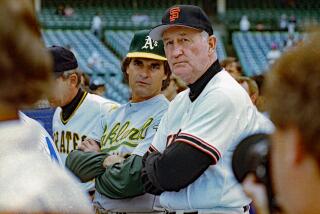Bret Saberhagen Changes His Pitch : Royals Pitcher Alters Routine, Too, and Makes Fast Start
- Share via
KANSAS CITY, Mo. — Most pitchers revive their careers by developing an extra pitch. Bret Saberhagen regained his Cy Young Award-winning form by getting rid of one.
He abandoned his unreliable slider and suddenly found his curveball snapping again.
Saberhagen, a 23-year-old right-hander, has experienced a Jekell and Hyde career with the Kansas City Royals. After going 20-6 with a 2.87 earned-run average in 1985, when he won the American League’s Cy Young Award and was named the most valuable player in the World Series, Saberhagen slumped last year to 7-12 with a 4.15 ERA.
This year a renewed Saberhagen has twice posted six-game winning streaks and was 12-2 with a 2.33 ERA through June 22. He is the main reason the Royals remained in striking distance of first place in the AL West. After pitching 115 innings, he had a 3-to-1 strikeout-to-walk ratio and had given up only 93 hits.
Saberhagen, who dominated batters during his high school days with a fastball, changeup and sharp-breaking curve, tried to develop a slider after turning professional. Instead of making him even more impressive on the mound, the slider only took away from his curve. That led to a decision to scrap the slider at the end of last season.
“This has certainly helped my pitching repertoire,” Saberhagen said recently. “I got caught between the curveball and slider. Neither one of them was where it should have been. The pitches weren’t all that great.
“I used to have a real good curveball, but when I started throwing the slider my curveball went downhill. I never really had both pitches going for me in any game. It was either one or the other, it was never both and sometimes neither. Now, the curveball’s the best it’s been probably since high school.”
Saberhagen not only decided to get rid of the slider but changed his offseason routine this year as well. Instead of remaining in Kansas City throughout the winter and working out in close quarters indoors, he went to Southern California a month before spring training to work outdoors.
He said, “I didn’t prepare myself properly (prior to the 1986 season), being in a cold climate instead of what I’m used to in the warm climate. Mentally, I didn’t prepare myself for anything. I never really got started last year.
“I was working out and throwing three days a week indoors (after the 1985 season). I wasn’t going outside and playing long toss and getting my arm strong,” Saberhagen said. “I was throwing only 90 feet. It didn’t help me stretch out.
“I’m used to being out in California, throwing five or six days a week and airing it out. That’s the way I’ve always gotten my arm strong, but I wasn’t able to do that in the winter of ’85.”
Before heading for California last winter, Saberhagen ran two miles a day on a treadmill and used weights to keep his throwing arm strong.
“Before, I’d always used arm weights to help on an injury. Now I’m using them to keep from getting injured,” he said.
Saberhagen plans to keep a strict training program next winter--in Southern California where the weather is conducive to outdoor workouts.
“I’m thinking about selling my house and moving back to California because I can’t get ready for spring out here,” he said. “I mainly just didn’t prepare myself for the 1986 season and I can’t let that happen again.”
More to Read
Go beyond the scoreboard
Get the latest on L.A.'s teams in the daily Sports Report newsletter.
You may occasionally receive promotional content from the Los Angeles Times.










